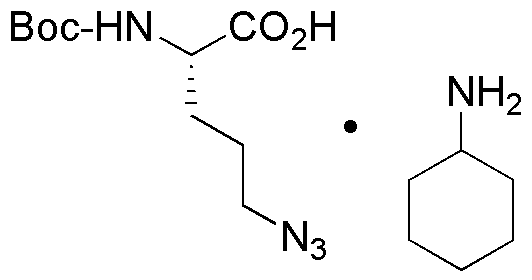Na-Boc-Nd-Azido-L-Ornithine cyclohexylammonium salt is widely utilized in research focused on:
- Peptide Synthesis: This compound serves as a key building block in the synthesis of peptides, particularly those with azide functionalities, enabling researchers to create complex structures for drug development.
- Click Chemistry: Its azido group allows for efficient click chemistry reactions, facilitating the conjugation of biomolecules, which is essential in creating targeted therapies and diagnostics.
- Bioconjugation: The compound is used in bioconjugation processes, where it helps attach drugs or imaging agents to proteins, enhancing their efficacy and specificity in therapeutic applications.
- Research in Drug Delivery: It plays a role in developing novel drug delivery systems, where its unique properties can improve the stability and release profiles of therapeutic agents.
- Biomedical Research: The compound is valuable in biomedical research for studying cellular processes and interactions, providing insights that can lead to advancements in disease treatment.
General Information
Properties
Safety and Regulations
Applications
Na-Boc-Nd-Azido-L-Ornithine cyclohexylammonium salt is widely utilized in research focused on:
- Peptide Synthesis: This compound serves as a key building block in the synthesis of peptides, particularly those with azide functionalities, enabling researchers to create complex structures for drug development.
- Click Chemistry: Its azido group allows for efficient click chemistry reactions, facilitating the conjugation of biomolecules, which is essential in creating targeted therapies and diagnostics.
- Bioconjugation: The compound is used in bioconjugation processes, where it helps attach drugs or imaging agents to proteins, enhancing their efficacy and specificity in therapeutic applications.
- Research in Drug Delivery: It plays a role in developing novel drug delivery systems, where its unique properties can improve the stability and release profiles of therapeutic agents.
- Biomedical Research: The compound is valuable in biomedical research for studying cellular processes and interactions, providing insights that can lead to advancements in disease treatment.
Documents
Safety Data Sheets (SDS)
The SDS provides comprehensive safety information on handling, storage, and disposal of the product.
Product Specification (PS)
The PS provides a comprehensive breakdown of the product’s properties, including chemical composition, physical state, purity, and storage requirements. It also details acceptable quality ranges and the product's intended applications.
Certificates of Analysis (COA)
Search for Certificates of Analysis (COA) by entering the products Lot Number. Lot and Batch Numbers can be found on a product’s label following the words ‘Lot’ or ‘Batch’.
Numéro de catalogue
Numéro de lot/série
Certificates Of Origin (COO)
This COO confirms the country where the product was manufactured, and also details the materials and components used in it and whether it is derived from natural, synthetic, or other specific sources. This certificate may be required for customs, trade, and regulatory compliance.
Numéro de catalogue
Numéro de lot/série
Safety Data Sheets (SDS)
The SDS provides comprehensive safety information on handling, storage, and disposal of the product.
DownloadProduct Specification (PS)
The PS provides a comprehensive breakdown of the product’s properties, including chemical composition, physical state, purity, and storage requirements. It also details acceptable quality ranges and the product's intended applications.
DownloadCertificates of Analysis (COA)
Search for Certificates of Analysis (COA) by entering the products Lot Number. Lot and Batch Numbers can be found on a product’s label following the words ‘Lot’ or ‘Batch’.
Numéro de catalogue
Numéro de lot/série
Certificates Of Origin (COO)
This COO confirms the country where the product was manufactured, and also details the materials and components used in it and whether it is derived from natural, synthetic, or other specific sources. This certificate may be required for customs, trade, and regulatory compliance.


